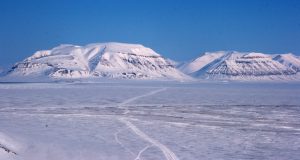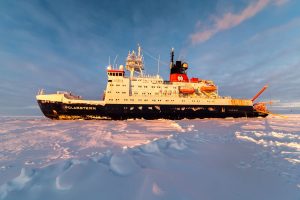Resources
Participation in economic projects for the exploitation of mineral and fossil raw materials in the Arctic is a magnet for investments from growing economies (such as China) and large industrial nations (such as Germany). Thus, the guidelines for the German Arctic policy (2013) also mention the option to “seize economic opportunities” (p. 6) in the Arctic, although with particular attention to the precautionary principle and the considerable environmental challenges in developing raw material deposits in the Arctic.
However, the development of Arctic resources is generally seen as an opportunity for the German and European economy. The importance of Arctic resources is presented against the background of Germany’s sustainable supply of raw materials and a long-term stable and ecologically compatible energy supply for German industries and consumers. In this sense, the use of raw material deposits in the Arctic is seen as an opportunity to make a contribution to Germany’s supply of raw materials. Germany already obtains most of its oil and gas imports from Norway and Russia, both countries with large fossil resource deposits and production in their Arctic regions.
Technology
The major technical challenges of Arctic resource development offer new opportunities for German companies and job creation in Germany. The Guidelines thus mention the relevance of German specialist knowledge in research, technology, and environmental standards for the sustainable development of the region. In particular, the potential for German marine technology due to the increasing importance of maritime activities for resource extraction is emphasised; the government’s National Master Plan Maritime Technologies of 2018 serves to release these potentials.
German companies are already suppliers for raw material extraction in the Arctic and researchers and experts are evaluating the Arctic mineral raw material potential. The Federal Institute for Geosciences and Natural Resources (BGR) in particular is active in this respect; the German Mineral Resources Agency (Deutsche Rohstoffagentur, DERA), which reports to it, analyses and evaluates mineral raw materials markets for the German economy, including the raw materials potential of the Arctic.
Shipping
German technology is also relevant for increased shipping volumes in the Arctic, as ships in the Arctic have to meet high and special standards despite the warmer temperatures. The German Arctic Guidelines (p. 9) mention in this respect a “market with great potential” for innovative shipbuilding. Further, Germany as “one of the world’s leading technology suppliers” with its shipyards and suppliers is said to offer innovative, environmentally friendly ship propulsion systems and the construction of special ships. As one of the world’s largest import and export nations with the third largest merchant fleet and the world’s largest container ship fleet, Germany is also interested in new routes to East Asian trading centres. In order to take advantage of opportunities to reduce travel time and costs, “the Federal Government actively backs the opening of new shipping routes in the Arctic” (German Arctic Guidelines, p. 8). At the same time, Germany stresses that the free passage of ships through Arctic shipping routes must be guaranteed.
Fisheries
The European Union and Germany are major buyers of fishery products from abroad, including the Arctic. Especially for Denmark/Greenland and Norway, European and therefore also German markets are of great importance for their fisheries exports. According to the German Arctic Guidelines (p. 6), 50% of the fish caught in the Arctic Ocean is already consumed in the EU and the increasing retreat of sea ice in Arctic summers could expand fishing grounds in the north. Therefore, fisheries is also mentioned as an area of new economic perspective in the German guidelines, which can be implemented under high environmental standards in the Arctic. In this context, Germany is working together with the EU within the framework of international fisheries organisations for the conservation and sustainable management of living marine resources in the Arctic.

